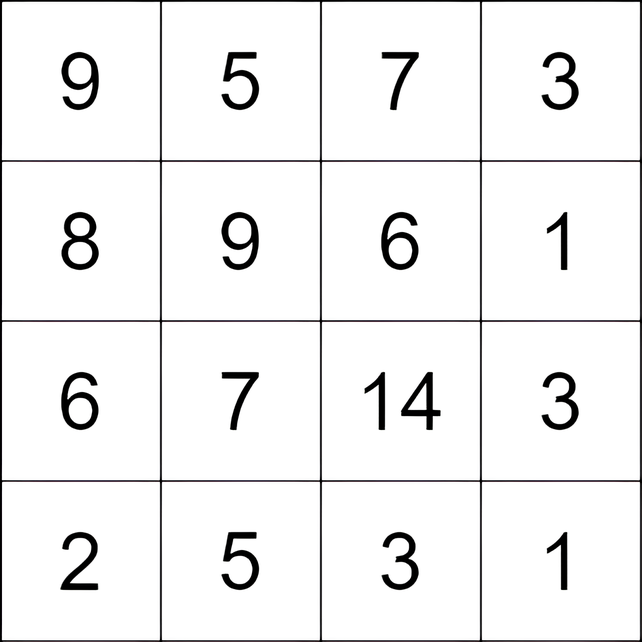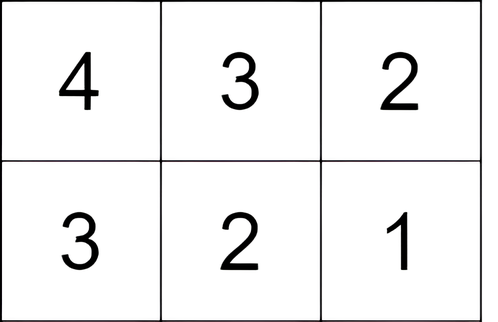| comments | difficulty | edit_url | tags | |||
|---|---|---|---|---|---|---|
true |
Medium |
|
You are given an m x n matrix grid consisting of positive integers. You can move from a cell in the matrix to any other cell that is either to the bottom or to the right (not necessarily adjacent). The score of a move from a cell with the value c1 to a cell with the value c2 is c2 - c1.
You can start at any cell, and you have to make at least one move.
Return the maximum total score you can achieve.
Example 1:
Input: grid = [[9,5,7,3],[8,9,6,1],[6,7,14,3],[2,5,3,1]]
Output: 9
Explanation: We start at the cell (0, 1), and we perform the following moves:
- Move from the cell (0, 1) to (2, 1) with a score of 7 - 5 = 2.
- Move from the cell (2, 1) to (2, 2) with a score of 14 - 7 = 7.
The total score is 2 + 7 = 9.
Example 2:
Input: grid = [[4,3,2],[3,2,1]]
Output: -1
Explanation: We start at the cell (0, 0), and we perform one move: (0, 0) to (0, 1). The score is 3 - 4 = -1.
Constraints:
m == grid.lengthn == grid[i].length2 <= m, n <= 10004 <= m * n <= 1051 <= grid[i][j] <= 105
According to the problem description, if the values of the cells we pass through are
We can use dynamic programming to solve this problem. We define
So the answer is the maximum value of
The time complexity is
class Solution:
def maxScore(self, grid: List[List[int]]) -> int:
f = [[0] * len(grid[0]) for _ in range(len(grid))]
ans = -inf
for i, row in enumerate(grid):
for j, x in enumerate(row):
mi = inf
if i:
mi = min(mi, f[i - 1][j])
if j:
mi = min(mi, f[i][j - 1])
ans = max(ans, x - mi)
f[i][j] = min(x, mi)
return ansclass Solution {
public int maxScore(List<List<Integer>> grid) {
int m = grid.size(), n = grid.get(0).size();
final int inf = 1 << 30;
int ans = -inf;
int[][] f = new int[m][n];
for (int i = 0; i < m; ++i) {
for (int j = 0; j < n; ++j) {
int mi = inf;
if (i > 0) {
mi = Math.min(mi, f[i - 1][j]);
}
if (j > 0) {
mi = Math.min(mi, f[i][j - 1]);
}
ans = Math.max(ans, grid.get(i).get(j) - mi);
f[i][j] = Math.min(grid.get(i).get(j), mi);
}
}
return ans;
}
}class Solution {
public:
int maxScore(vector<vector<int>>& grid) {
int m = grid.size(), n = grid[0].size();
const int inf = 1 << 30;
int ans = -inf;
int f[m][n];
for (int i = 0; i < m; ++i) {
for (int j = 0; j < n; ++j) {
int mi = inf;
if (i) {
mi = min(mi, f[i - 1][j]);
}
if (j) {
mi = min(mi, f[i][j - 1]);
}
ans = max(ans, grid[i][j] - mi);
f[i][j] = min(grid[i][j], mi);
}
}
return ans;
}
};func maxScore(grid [][]int) int {
m, n := len(grid), len(grid[0])
f := make([][]int, m)
for i := range f {
f[i] = make([]int, n)
}
const inf int = 1 << 30
ans := -inf
for i, row := range grid {
for j, x := range row {
mi := inf
if i > 0 {
mi = min(mi, f[i-1][j])
}
if j > 0 {
mi = min(mi, f[i][j-1])
}
ans = max(ans, x-mi)
f[i][j] = min(x, mi)
}
}
return ans
}function maxScore(grid: number[][]): number {
const [m, n] = [grid.length, grid[0].length];
const f: number[][] = Array.from({ length: m }, () => Array.from({ length: n }, () => 0));
let ans = -Infinity;
for (let i = 0; i < m; ++i) {
for (let j = 0; j < n; ++j) {
let mi = Infinity;
if (i) {
mi = Math.min(mi, f[i - 1][j]);
}
if (j) {
mi = Math.min(mi, f[i][j - 1]);
}
ans = Math.max(ans, grid[i][j] - mi);
f[i][j] = Math.min(mi, grid[i][j]);
}
}
return ans;
}
